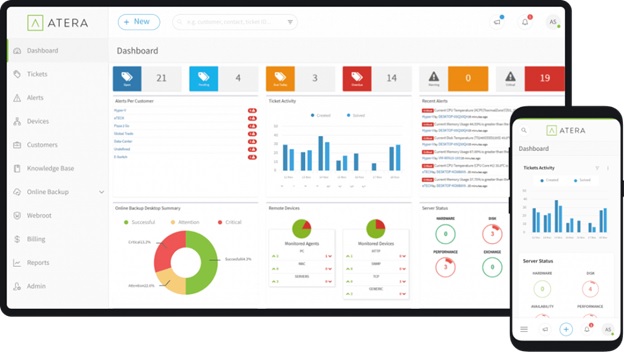RMM stands for “Remote Monitoring and Management.” This category of software is essential for managed service providers (MSPs) and IT professionals. RMM will help you to fulfill your contractual obligations to our clients and their employees.
What are the Advantages of a Good RMM?
An RMM will save your business money because it cuts down costly help desk calls. It will alert your IT support staff to potential crises so they can be fixed before they damage the business. With ComNET MSP onboard, the RMM monitoring software will avert system failure and reduce the number of IT support staff that you need – especially if you have a multi-site operation.
MSPs cannot operate without RMM technology. A competent RMM will reduce your overheads and enable you to win more business by offering a more reliable service at a lower price.
Real-Time Monitoring and Alerts
 Your users shouldn’t have to wait for something to break down before the support team spots a problem. An MSP supporting the infrastructure on a remote client site will know about potential problems so that they can fix them before they grind the client’s business to a halt.
Your users shouldn’t have to wait for something to break down before the support team spots a problem. An MSP supporting the infrastructure on a remote client site will know about potential problems so that they can fix them before they grind the client’s business to a halt.
IT Automation and Scripting
Automation takes care of many routine maintenance tasks, freeing up IT support for more complex jobs. Automated tasks should include:
- Create system restore points
- Delete temp files
- Delete internet history
- Reboot
- Shutdown
- Defragment (all disks)
- Run Checkdisk (all disks)
- Run scripts
A script execution module is important because it makes automation very flexible. An RMM can support scripts written in many formats, including MSI, Bash files, CMD files, and PowerShell scripts. A service that includes a library of pre-written scripts is also a good sign of a well-thought-out RMM. Some software houses encourage their user communities to share scripts.
The automation features of good RMM monitoring software will reduce your staff needs. The cost savings offered by an RMM are the key to the MSP support software advantage.
Patch Management Functions
A patch manager module enables you to shut down the operating system and software exploits by automating patch management. You should be able to choose when updates will be installed to cause minimum disruption. Then you can leave the rollout to the RMM. The system should be able to:
- Run Windows Updates
- Install Microsoft Office Updates
- Install driver updates
- Install Java updates
- Install Adobe updates
- Reboot if needed
- Exclude patches
The RMM console should display patch run statuses and log all actions so your technicians can check on the current status of all software at any time.
Reporting and Analytics
An RMM doesn’t just perform monitoring tasks, it should also include extensive reporting options that allow you to set data-drive goals for your IT support activities. Reports should be available to be run on-demand or through a schedule. A nice extra is the option to set reports to be delivered via email so your technicians don’t need to worry about distributing information.
Standard reports should include:
- System health at a glance
- Specific customer health
- Agent health
- System inventory audit
- Microsoft licensing
- Software inventory
- Patch and automation feedback
Regular report runs enable you to track activities and provide supporting documentation for billing as well as feedback for task completion.
Device Monitoring and Management
 A typical RMM tool includes two elements. The first of these is the management console. This is the software that gives the technician access to RMM functions. The second element is an “agent,” which is installed on the client device. The agent gives the technician access to the monitored remote equipment.
A typical RMM tool includes two elements. The first of these is the management console. This is the software that gives the technician access to RMM functions. The second element is an “agent,” which is installed on the client device. The agent gives the technician access to the monitored remote equipment.
The agent scans equipment for status changes and reports back to the central monitoring console over the network or across the internet. The proactive approach of RMM agents means that the MSP’s system administrator can spot service-level problems before system errors impact on performance. This lets MSP staff take action without having to wait for users to raise the alarm. An RMM alarm is termed a “ticket,” which is the same terminology used by help desk systems to track user-raised issues.
The access afforded by the remote agents enables the central MSP-based technician to access the equipment on client sites to fix, reconfigure and/or install and update the client software. These software inventory and configuration tasks can be performed on individual devices or implemented en masse.
The processes of monitoring and updating software remotely can be automated. So once a patch or update is received, it can be rolled out to all of a client’s machines without manual intervention. All of the RMM facilities means that a supporting IT technician never needs to visit the client’s site.
PSA and RMM
 Managed service providers can operate from anywhere in the world and service users remotely. However, this reach is only possible thanks to RMM, remote monitoring software. While RMM gets you access to client endpoints and users, you also need a platform that will track the work of your support operators and ensure that you are keeping to the service level agreements that you contracted with your clients. These MSP support services are provided by a category of software that is called “professional services automation,” or PSA.
Managed service providers can operate from anywhere in the world and service users remotely. However, this reach is only possible thanks to RMM, remote monitoring software. While RMM gets you access to client endpoints and users, you also need a platform that will track the work of your support operators and ensure that you are keeping to the service level agreements that you contracted with your clients. These MSP support services are provided by a category of software that is called “professional services automation,” or PSA.
So MSPs need two types of software in order to successfully support their clients: PSA to manage tasks and RMM to facilitate communications. Your operators will use RMM in their tasks, and you will keep track of performance with a PSA. There is an overlap between the support offered by PSA and RMM because technicians will refer to the PSA to gain stored information about the client endpoint that needs to be accessed and the user that made a support call.
The Break/Fix model
Traditionally, businesses working on a tight budget work to the philosophy of “if it ain’t broke, don’t fix it.” They don’t spend money on IT support until something breaks. At that point, they search for a technician, and they usually need repairs to be completed in a hurry.
Small businesses that don’t have an established relationship with a managed services provider for IT support tend to call on technicians on an ad hoc basis. The infrequency of breakdowns means that quite often equipment-using staff can’t remember who they called the last time they had an emergency.
Calling around for quotes take time, and inoperative infrastructure will cost the business lost income. Therefore, repairs are ordered in a panic with no consideration for cost. This is the Break/Fix model.
Waiting for something to break is a risky strategy, and, in the long run, costs more than operating a continuous maintenance contract. There is a better way to run a corporate IT policy — automated constant monitoring of equipment to head off breakdowns.
Atera’s all-in-one package
Atera is an all-in-one solution. It has all that you need to run IT support successfully. You can manage and monitor IT assets remotely with this package, and the PSA, hosting, and anti-virus integrations make Atera a one-stop-shop for MSPs and IT support departments.
As a cloud-based RMM service, Atera makes remote support technology available to very small MSP operators. Sole traders can now offer support services to clients from home without the need to run on-premises RMM software or even maintain servers. Thanks to the “software as a service” model, a support technician can run an MSP business with just a laptop and an internet connection.
With Atera, you pay per technician per month, so a startup MSP doesn’t have to pay up front for equipment and software. Instead, you only have to pay for the platform for the small number of technicians that are active – as the business expands, the RMM is available to a larger number of technicians working in the business simply by adding on more subscriptions.

